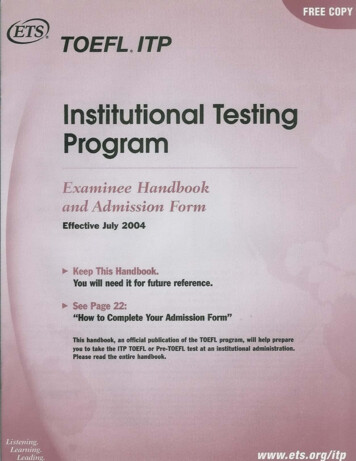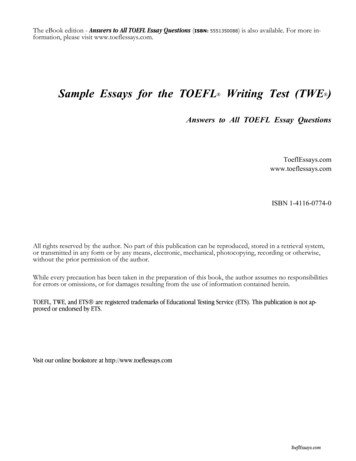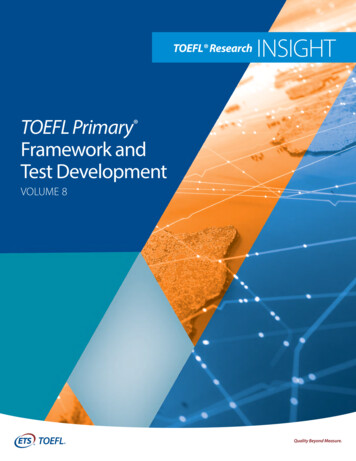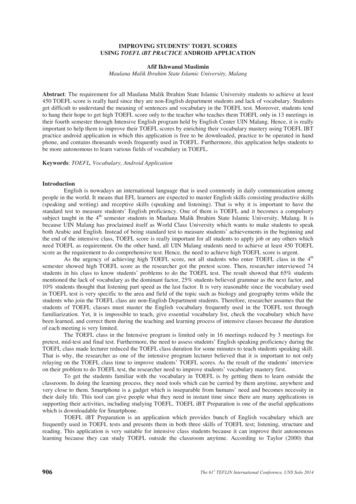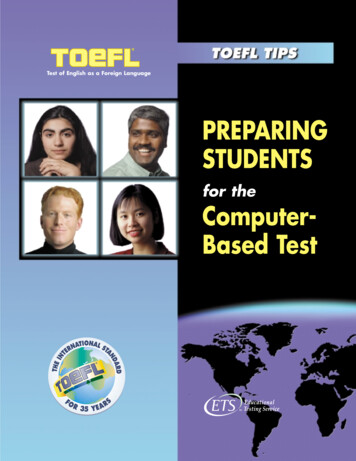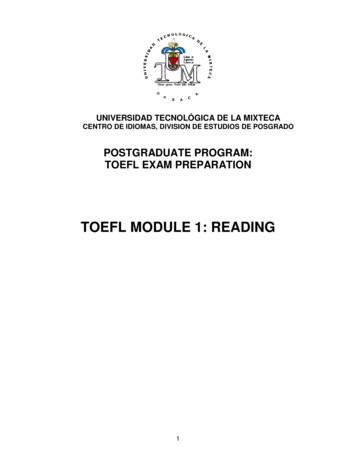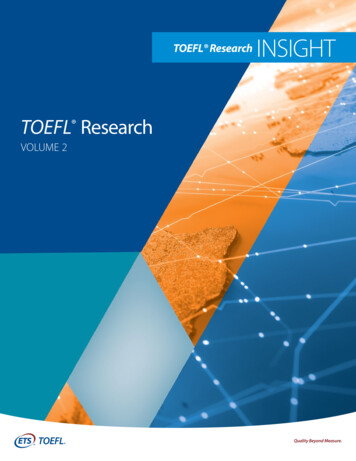
Transcription
TOEFL ResearchTOEFL ResearchVOLUME 2INSIGHT
TOEFL Research Insight Series, Volume 2: TOEFL ResearchPrefaceThe TOEFL iBT test is the world’s most widely respected English language assessment and used for admissionspurposes in more than 150 countries, including Australia, Canada, New Zealand, the United Kingdom, and theUnited States (see test review in Alderson, 2009). Since its initial launch in 1964, the TOEFL test has undergoneseveral major revisions motivated by advances in theories of language ability and changes in English teachingpractices. The most recent revision, the TOEFL iBT test, was launched in 2005. It contains a number ofinnovative design features, including integrated tasks that engage multiple skills to simulate language use inacademic settings and test materials that reflect the reading, listening, speaking, and writing demands ofreal-world academic environments.In addition to the TOEFL iBT test, the TOEFL Family of Assessments was expanded to provide high-quality,English proficiency assessments for a variety of academic uses and contexts. The TOEFL Young StudentsSeries features the TOEFL Primary and TOEFL Junior tests, which are designed to help teachers and learners ofEnglish in school settings. In addition, the TOEFL ITP program offers colleges, universities, and othersaffordable tests for placement and progress monitoring within English programs as a pathway to eventualdegree programs.At ETS, we understand that scores from the TOEFL Family of Assessments are used to help make importantdecisions about students, and we would like to keep score users and test takers up-to-date about the researchresults that help assure the quality of these scores. Through the publication of the TOEFL Research InsightSeries, we wish to communicate to institutions and English teachers who use the TOEFL tests the strongresearch and development base that underlies the TOEFL Family of Assessments and demonstrate ourcontinued commitment to research.Since the 1970s, the TOEFL test has had a rigorous, productive, and far-ranging research program. But whyshould test score users care about the research base for a test? In short, it is only through a rigorous programof research that a testing company can substantiate claims about what test takers know or can do based ontheir test scores, as well as provide support for the intended uses of assessments and minimize potentialnegative consequences of score use. Beyond demonstrating this critical evidence of test quality, research isalso important for enabling innovations in test design and addressing the needs of test takers and test scoreusers. This is why ETS has established a strong research base as a fundamental feature underlying theevolution of the TOEFL Family of Assessments.This portfolio is designed, produced, and supported by a world-class team of test developers, educationalmeasurement specialists, statisticians, and researchers in applied linguistics and language testing. Our testdevelopers have advanced degrees in fields such as English, language education, and applied linguistics. Theyalso possess extensive international experience, having taught English on continents around the globe. Ourresearch, measurement, and statistics teams include some of the world’s most distinguished scientists andinternationally recognized leaders in diverse areas such as test validity, language learning and assessment, andeducational measurement.2TOEFL Research Insight Series, Volume 2: TOEFL Research
To date, more than 300 peer-reviewed TOEFL Family of Assessments research reports, technical reports, andmonographs have been published by ETS, and many more studies on the TOEFL tests have appeared inacademic journals and book volumes. In addition, over 20 TOEFL test-related research projects are conductedby ETS’s Research & Development staff each year and the TOEFL Committee of Examiners — comprisinglanguage learning and testing experts from the global academic community — funds an annual program ofTOEFL Family of Assessments research by independent external researchers from all over the world.The purpose of the TOEFL Research Insight Series is to provide a comprehensive, yet user-friendly account ofthe essential concepts, procedures, and research results that assure the quality of scores for all products in theTOEFL Family of Assessments. Topics covered in these volumes feature issues of core interest to test users,including how tests were designed; evidence for the reliability, validity, and fairness of test scores; andresearch-based recommendations for best practices.The close collaboration with TOEFL test score users, English language learning and teaching experts, anduniversity scholars in the design of all TOEFL tests has been a cornerstone to their success and worldwideacceptance. Therefore, through this publication, we hope to foster an ever-stronger connection with our testusers by sharing the rigorous measurement and research base, as well as solid test development, thatcontinues to help ensure the quality of the TOEFL Family of Assessments.John Norris, Ph.D.Senior Research DirectorEnglish Language Learning and AssessmentResearch & Development DivisionETSThe following individuals contributed to the second edition (2018) and the third edition (2020) by providing careful reviews and revisions as well as editorial suggestions (in alphabetical order): Terry Axe,Ian Blood, Jill Burstein, Ikkyu Choi, Keelan Evanini, Yoko Futagi, Michelle Hampton, Marcel Ionescu, Spiros Papageorgiou, Eileen Tyson, Lin Wang, and Klaus Zechner. The primary author of the first editionwas Mary K. Enright. Cristiane Breining, Brent Bridgeman, Don Powers, Rosalie Szabo, Xiaofei Tang, Eileen Tyson, Mikyung Kim Wolf, and Xiaoming Xi also contributed to the first edition.TOEFL Research Insight Series, Volume 2: TOEFL Research3
TOEFL ResearchThe TOEFL program has long recognized and supported the importance of research in maintaining andimproving test quality. Since the mid-1970s, a portion of the annual TOEFL budget has been committed tofund and disseminate research on issues related to language assessment. ETS supports a research program toadvance knowledge in the field of language assessment and second-language acquisition. The goals are to: improve language assessments and related products, assure that they meet professional standards, and develop the foundation for new products and services.The TOEFL Committee of Examiners (COE), a body of twelve individuals from around the world, each of whomhas achieved professional recognition in an academic field related to English as a second or foreign language,works closely with ETS on its program of research.The Research ProcessTOEFL research is carried out in consultation with the COE. It advises the TOEFL program about researchneeds and, through its Research Subcommittee, administers the COE research program. Through thisprogram, the COE solicits, reviews, and approves the funding of research proposals from experts aroundthe globe. The TOEFL program also funds an extensive program of research conducted at ETS by itsown staff.To encourage external experts to conduct TOEFL research, the COE publishes an annual announcementof its research program, describing high-priority research topics. Applications are invited from researchprofessionals who have expertise in English language learning and assessment and who are affiliated withresearch institutions, such as universities or not-for-profit organizations. The COE Research Subcommitteereviews the preliminary funding applications. Invitations to submit a full proposal are issued to selectedapplicants based on the quality of the preliminary application. Full research proposals are then evaluatedin terms of their relevance to the identified research topics, the feasibility and quality of the proposedresearch, the qualifications of the principal investigator, organizational capacity to conduct the research,and cost effectiveness.The quality of TOEFL research is ensured through a rigorous review process. Three to four ETS andexternal experts review proposals and reports. The reviewers may include applied linguists, psychologists,statisticians, psychometricians, or assessment specialists. After reports are reviewed, researchers areencouraged to disseminate their findings in professional journals or as TOEFL reports.The TOEFL program also provides a variety of other monetary grants and awards to recognize and supportsignificant activities or projects related to the field of English language education, and to promote highquality language assessment research.Small grants are available to promising students working in the area of foreign- or second-languageassessment, to help them finish their dissertations in a timely manner. Grants are also available toenable practitioners to become involved in ETS’s efforts in promoting English learning and to encourage4TOEFL Research Insight Series, Volume 2: TOEFL Research
the broad dissemination of information on English language testing, teaching, and teacher educationthrough presentations at conferences outside the United States.Information about TOEFL research grants and awards is published at https://www.ets.org/toefl/grants.Description of Selected TOEFL ResearchMore than 200 TOEFL related research reports have been published by ETS (https://www.ets.org/toefl/research).Moreover, since the year 2000 alone, more than 100 academic journal articles and book chapters on TOEFLrelated research have been published, as well as two books and more than 100 presentations at academicconferences. Certain research topics such as test validation, fairness, and reliability have been repeatedlyre-examined over time as test methods and content evolved. Other topics include innovations in testing(such as advances in psychometrics, automated scoring, and computer-based testing) and projects focusedon the implications of theories of language proficiency for test design.A comprehensive summary of all the research sponsored by ETS is well beyond the scope of this document.Nevertheless, in the pages that follow, we will make a selective presentation concentrating on topics notreviewed in other publications. The extensive program of research to improve language assessment thatresulted in the TOEFL iBT test is documented in a book edited by Chapelle, Enright, and Jamieson (2008).Summaries of research and procedures to ensure that the TOEFL test complies with professional standardsfor validity (ETS, 2020c) and reliability (ETS, 2020a) are available. In this section, we will focus on researchconcerning test fairness and automated analysis of writing and speaking.Research on Test FairnessFairness in testing is an important measurement standard that the TOEFL program strives to meet. For theTOEFL test, test fairness means that the test scores can be interpreted as a measure of academic Englishlanguage ability for various groups of test takers. Fairness requires that test scores should not be affected byfactors that are not relevant to this intended interpretation. Although care is taken during test development toensure that test content meets fairness guidelines, empirical research studies are also conducted to determinethe impact of various factors on test scores. Four studies have addressed three fairness issues related toTOEFL iBT test scores: (a) the structure of the test for different groups of test takers, (b) the impact ofeducational and cultural background on reading performance, and (c) the performance of nativeEnglish-speaking college students on the TOEFL iBT test.One fairness issue concerns what specialists refer to as the factor structure of test scores for different groupsof test takers. Factor analysis is a statistical research method that can be used to determine the underlyingstatistical structure of scores on a test. The factor structure of a test should be consistent with the theoreticalstructure implied by the test’s construct—the characteristic that the test is designed to measure (e.g., Englishlanguage proficiency). A test’s factor structure also has implications for how scores should be reported andinterpreted. Stricker and Rock (2008) analyzed the factor structure of a 2003–2004 TOEFL iBT field test form forthree groups of test takers. Test takers were grouped according to (a) whether their first language was from anIndo European versus a non–Indo European language family, (b) how widely English was used in educationand business contexts in their native countries, and (c) years of studying the English language in school. Thesame factor structure was found for all subgroups. Analyses of operational TOEFL iBT test forms (Gu, 2014;TOEFL Research Insight Series, Volume 2: TOEFL Research5
Manna & Yoo, 2015; Sawaki & Sinharay, 2013) also showed that the test’s factor structure was consistent acrossdifferent groups defined by first language and test taker background characteristics. A consistent factorstructure across different groups of test takers provides evidence that the test measures the same constructfor the groups studied and that score aggregation and reporting procedures lead to appropriate scoreinterpretations for these groups.Another important question that researchers have asked about the fairness of the TOEFL iBT test is whetherfactors other than English language proficiency impact test performance. Liu, Schedl, Malloy, and Kong (2009)asked this question in regard to the TOEFL iBT Reading section, which has fewer but longer reading passagesthan previous versions of the TOEFL test. Their concern was that the decreased topic variety might increase thelikelihood that test takers’ familiarity with the particular topic of a given passage would influence their readingperformance on the test. Accordingly, they investigated whether TOEFL iBT test reading performance wasaffected by test takers’ outside knowledge, gained either through academic major or from immersionin a particular culture. Performance on six passages and associated questions from five TOEFL iBT testadministrations were examined. Three of the passages focused on topics in physical science, and the restemphasized European or Japanese cultures. Techniques known as differential item functioning (DIF) anddifferential bundle functioning (DBF) were used to investigate the impact of outside knowledge on TOEFL iBTtest reading performance. DIF occurs for an item when differences in performance exist after examinees arematched on the abilities that the item is intended to measure. Liu et al. found little evidence that the sourcesof outside knowledge they investigated influenced overall performance on the reading passages. Further, theanalysis of the items displaying DIF suggests that the differences in performance may be construct-relevantdifferences that TOEFL iBT test is intended to measure (e.g., vocabulary knowledge). To ensure continuedfairness, the researchers recommended that passages containing technical vocabulary or culture-specificknowledge should be carefully scrutinized in the future.Another study (Hill & Liu, 2012) explored the interaction between test takers’ language proficiency andbackground knowledge, with the focus on their discipline-specific knowledge and cultural familiarity. Thestudy reanalyzed the data used in Liu et al. (2009) employing DIF methods and concluded: “When examinedholistically, the TOEFL iBT reading passages were neither advantageous nor disadvantageous to those whohad physical science backgrounds or were familiar with a certain culture, and this holds for both the lower andhigher proficiency groups” (Hill & Liu, 2012, p. 28).A third fairness concern is that the TOEFL iBT test, with its academic content and tasks that require integratingdifferent language skills, might be very difficult even for native English speakers. Native speakers, overall, donot represent the “ultimate criterion group for an ESL test, because they vary in formal and informal educationin English and in linguistic ability” (Stricker, 2002, p. 1). Nevertheless, if educated native English speakerscannot do as well as educated non-native speakers on the TOEFL iBT test, it might be claimed that non-nativespeakers are being held unfairly to a higher standard in admissions decisions than native speakers. Cline andPowers (2009) compared the performance of first-year college students who were native speakers of Englishwith that of non-native speakers. They administered one form of the 2003–2004 TOEFL iBT field test to morethan 900 first-year, native English-speaking students at community colleges and nonselective 4-year collegesand compared their performance with that of the non-native speakers who had completed the field studyform. Overall, the native English-speaking college students performed better than non-native speakers,although there was a reasonable amount of variation in scores within this group. The mean score differences6TOEFL Research Insight Series, Volume 2: TOEFL Research
favoring the native English speakers were moderate for listening and reading, but large for speaking andthe total score. The implications are that the TOEFL iBT test is neither inappropriately difficult for non-nativeEnglish speakers nor unusually easy for native English speakers. This suggests that non-native speakers arebeing held to a high standard, but not an unfair one.In sum, these studies of test structure, test content, and native-speaker performance illustrate some of thefairness issues that have been addressed empirically through TOEFL research.Automated Scoring for Writing and SpeakingTwo needs arise when a test includes extended constructed-response tasks, such as the Writing and Speakingtasks on the TOEFL iBT test. One of these is the need to score the responses efficiently and reliably. The other isto provide test takers with opportunities to practice and receive feedback on their performance prior to takingthe test. Through research on automated scoring of writing and speaking, ETS and the TOEFL program havebeen laying the foundation for new products and services that address these needs. Capabilities developed atETS that address these needs include the e-rater and the SpeechRater engines.e-rater EngineThe e-rater engine uses natural language processing methods to automatically score test takers’ essays as wellas to provide feedback on the quality of their writing. The e-rater engine identifies errors in grammar, usage,and mechanics, as well as discourse structure and undesirable stylistic features in an essay. These features,along with measures of the vocabulary and sentence variety used in the essay, go into the e-rater engine’sstatistical model to predict human holistic ratings on essays. The engine is also used in practice-and-learningproducts such as Criterion Online Writing Evaluation Service and TOEFL Practice Online (TPO ) practice tests.The Criterion service is a web-based instructional tool that helps students plan, write, and revise essays; it usesthe e-rater engine to provide instant scoring and annotated diagnostic feedback.An extensive program of research contributed to the continuous development and refinement of thesecapabilities and their evaluation for use in different contexts. Although this research initially focused onanalyzing and scoring essays written primarily by native English speakers (e.g., Kaplan et al., 1998), attentionsoon expanded to include research on essays written specifically by non-native English speakers (e.g.,Chodorow & Burstein, 2004).One area of research interest is the validity of using the e-rater engine in conjunction with human raters toscore the TOEFL iBT Writing tasks (for more information about the use of the e-rater engine in scoringTOEFL iBT Writing tasks, see Volume 3: Reliability and Comparability of TOEFL iBT Scores). In their summaryof research on the use of the e-rater engine for the independent Writing task, Enright and Quinlan (2010)reported that the e-rater engine has been found to agree with human raters as well as or better than humanraters agree with each other when rating these essays. Overall, the empirical evidence summarized byEnright and Quinlan supports the use of the e-rater engine as a complement to human raters to scoreTOEFL test independent essays. Research has also been conducted to evaluate the use of the e-rater enginefor the integrated Writing task, which requires test takers to summarize and synthesize academic readingand listening materials in writing. The areas of research included the degree of agreement of the e-raterTOEFL Research Insight Series, Volume 2: TOEFL Research7
engine with human scores, the relationships of human and e-rater engine scores to independent indicatorsof language ability, and the impact of the use of the e-rater engine on scores by demographic subgroup. Theresults yielded evidence in support of the use of the e-rater engine to complement human raters for theTOEFL test integrated Writing task as well. These studies are summarized in Ramineni, Trapani, Williamson,Davey, and Bridgeman (2012).ETS is also continually conducting research on the technology underlying the e-rater engine, to improveexisting features as well as to expand construct coverage of the engine. Such research includes, for example,studies on preposition and comma error detection (Israel, Tetreault, & Chodorow, 2012; Tetreault, Foster,& Chodorow, 2010). Burstein, Flor, Tetreault, Madnani, and Holtzman (2012) systematically examined theparaphrase strategies used by native and non-native English speakers in a TOEFL test integrated task, as a firststep toward informing the development of new e-rater engine features. Beigman Klebanov, Madnani, Burstein,and Somasundaran (2014) described a method of automatically detecting effective use of source (e.g.,stimulus lecture) in a TOEFL test integrated task.Collaboration between the TOEFL program and ETS’s Research & Development division has made a uniquecontribution to the field of natural language processing and corpus linguistics, too, by making it possible to releasethe ETS Corpus of Non-Native Written English (Blanchard, Tetreault, Higgins, Cahill, & Chodorow, 2013), which ispublicly available through the Linguistic Data Consortium. The corpus consists of 12,100 English essays writtenfor the TOEFL test by speakers of eleven non-English native languages (1,100 per language) during 2006–2007.Originally developed with the specific task of native language identification in mind, the corpus can support awide range of applications of natural language processing to the educational domain, including grammatical errordetection and correction, automatic essay scoring, and studies in corpus linguistics.SpeechRater EngineAutomated scoring of speech is a more recent development than automated scoring of writing and presentsa greater challenge, in part because of the difficulty of automatically recognizing the words uttered in aresponse consisting of continuous speech. While speech scoring systems for simple tasks that require theproduction of a limited or predictable range of vocabulary have been in use for a number of years (seeZechner, Higgins, Xi, & Williamson, 2009, for a review), the tasks on the TOEFL iBT test Speaking sectionare more complex. The Speaking section includes four tasks that require test takers to respond either toa relatively general question or to oral and/or written input. TOEFL iBT test spoken responses are scoredholistically by human raters using a four-point scale; however, the raters are instructed to attend to three keyaspects of performance: delivery, language use, and topic development (see ETS, 2020b). In addition, theSpeechRater engine also computes scores for a response to each TOEFL iBT test Speaking task, and human andautomated scores are then combined using a contributory scoring approach, to produce a score for the task.Statistical analyses of the PRMSE value — that is, the proportional reduction of mean squared error (a metric ofmeasurement reliability) — demonstrated that this combined score results in higher assessment reliability forthe Speaking section (0.83) than either human scores (0.75) or machine scores (0.76) alone.Apart from being part of a hybrid human-machine contributory scoring approach for operational TOEFL iBT testSpeaking tasks, the SpeechRater engine is currently also used to provide sole scores for responses to TOEFL iBTtest Speaking tasks in the practice environment of TOEFL Practice Online (Zechner et al., 2009), the TOEFL Go! 8TOEFL Research Insight Series, Volume 2: TOEFL Research
App, and the TOEFL MOOC (massive open online course). The engine consists of four components: a speechrecognizer, a feature computation module, a filtering model, and a scoring model. The speech recognizerprovides a word sequence based on the recorded response of a test taker and was trained on around 1,600hours of responses by non-native English speakers to TOEFL iBT Speaking tasks. The feature computationmodule uses the output of the speech recognizer to compute a set of features related to various aspects ofspeaking proficiency (e.g., fluency, pronunciation, vocabulary). The filtering model flags responses that shouldnot be scored by the SpeechRater engine (e.g., responses with no speech or with high levels of noise). The scoringmodel uses the features from the feature computation module to statistically predict a score for each response.Research related to SpeechRater scoring system has addressed many aspects of system quality, including theconstruct coverage of the scoring features and the prediction accuracy of the scoring model (Chen et al., 2018;Loukina, Zechner, Chen, & Heilman, 2015; Zechner et al., 2009; Zechner & Evanini, 2019). The engine’s speechrecognizer provides information about word identity and timing. Speech scientists at ETS have developed morethan 100 features that are extracted from the output of the speech recognizer and other signal processingand natural language processing software. These features are consistent with the construct of communicativelanguage ability as embodied in the TOEFL iBT scoring guidelines. They are mainly related to the delivery andlanguage use areas of the TOEFL iBT scoring guidelines for spoken responses, measuring aspects of fluency,pronunciation, prosody, vocabulary, and grammar. There are also some features related to the content anddiscourse aspects of TOEFL iBT Speaking responses. To build the SpeechRater engine’s scoring model, only asubset of the available features is used. The goal here is to select features for a broad coverage of the construct,minimizing features that are highly correlated to other features in the model, and selecting features with highcorrelations to human rater scores (Loukina et al., 2015). For SpeechRater version 19.1, which was deployed forTOEFL TPO in 2019 using data from the TOEFL Practice Online Speaking section, the correlation between theSpeechRater scores and human scores was 0.75, while the correlation between two human raters was 0.84 (forsection-level scores on the Speaking section with 4 items).Research on the SpeechRater engine is ongoing, with the goals of (a) improving the accuracy of the speechrecognizer, (b) developing features to provide better coverage of the construct, and (c) improving theagreement of the SpeechRater scores with those of human raters.Explore TOEFL ResearchThis brief description of a few studies does little to convey the extent of the contribution that ETS and theTOEFL program have made to advancing knowledge of language assessment. Descriptions of more than 200research studies are available on the TOEFL website, illustrating the program’s commitment to advancing thefield and meeting high standards for educational measurement. To view these descriptions and downloadselected reports, visit the TOEFL research website (https://www.ets.org/toefl/research).TOEFL Research Insight Series, Volume 2: TOEFL Research9
ReferencesAlderson, J. C. Test review: Test of English as a Foreign Language : Internet-based Test (TOEFL iBT ). LanguageTesting, 26(4), 621-631. doi:10.1177/0265532209346371Beigman Klebanov, B., Madnani, N., Burstein, J., & Somasundaran, S. (2014). Content importance models forscoring writing from sources. In Proceedings of the 52nd Annual Meeting of the Association for ComputationalLinguistics (Short papers) (pp. 247–252). Stroudsburg, PA: Association for Computational Linguistics.Blanchard, D., Tetreault, J., Higgins, D., Cahill, A., & Chodorow, M. (2013). TOEFL11: A corpus of non-nativeEnglish (Research Report No. RR-13-24). Princeton, NJ: Educational Testing b02331.xBurstein, J., Flor, M., Tetreault, J., Madnani, N., & Holtzman, S. (2012). Examining linguistic characteristics ofparaphrase in test-taker summaries (Research Report No. RR-12-18). Princeton, NJ: Educational Testing Service.Chapelle, C. A., Enright, M. K., & Jamieson, J. (Eds.). (2008). Building a validity argument for the Test of English as aForeign Language. New York, NY: Routledge.Chodorow, M., & Burstein, J. (2004). Beyond essay length: Evaluating e-rater’s performance on TOEFL essays(TOEFL Research Report No. 73). Princeton, NJ: Educational Testing Service.Cline, F., & Powers, D. E. (2009). The new generation TOEFL: Evaluating its use with native speakers of English.Unpublished manuscript.Educational Testing Service. (2020a). Reliability and comparability of TOEFL iBT scores. TOEFL Research InsightSeries (Vol. 3, 3rd ed.).Educational Testing Service. (2020b). TOEFL iBT test framework and test development. TOEFL Research InsightSeries (Vol. 1, 3rd ed.).Educational Testing Service. (2020c). Validity evidence supporting the interpretation and use of TOEFL iBTscores. TOEFL Research Insight Series (Vol. 4, 3rd ed.).Enright, M. K., & Quinlan, T. (2010). Complementing human judgment of essays written by E
2 TOEFL Research sht Seres Ve TOEFL Research TOEFL Research Insight Series, Volume 2: TOEFL Research Preface The TOEFL iBT test is the world's most widely respected English language assessment and used for admissions purposes in more than 150 countries, including Australia, Canada, New Zealand, the United Kingdom, and the United States (see test review in Alderson, 2009).

